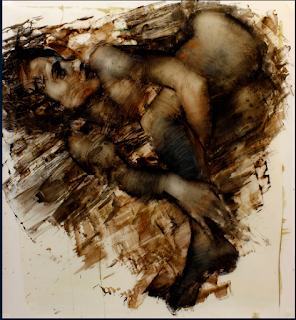I especially love the salt marsh at Black's Creek--Black's Creek runs through Quincy's Merrymount Park--at dawn and dusk. Especially in winter, the sweep of its wide, clean barrenness agrees with me. It's one of the first places that the increase in light--be it in the early morning or the late afternoon--can be readily discerned once the first dark weeks of January are over.
January--soon to be upon us--offers a blank, slow endlessness to our imaginations; December, in contrast, glitters, dazzles, expects, distracts, and demands. There's often little to no time in December for walking, for writing, for reading. So much doing and driving. So much stirring and stacking and baking and bringing. Even so much singing. And in the December 2019 season of impeachment, so much shouting and squaring off.
If ever there has been a December that has needed art and poetry, this one is it. Darkness sends us home both wired and exhausted from the ride home's traffic and the latest news, but with many busy hours to go before we sleep.
When I finally stop doing--because I'm finally "ready," finally "done" with singing concerts, with writing cards, with cooking and baking, with wrapping gifts, with catching up on the latest grandstanding--I can often feel myself still churning, thinking and moving at the frantic, productive pace that has gotten me to "done" and "informed." At those moments, the silence and stillness for which I've claimed to be hankering sit on me like a scratchy, ill-fitting coat.
There's a transition that needs to happen, and sitting still with music, visual art, and poetry helps. Poetry reminds us--or at least me--that my heart beats with something more than the day's push, rush, and rage. So this morning I pushed back against "doing," sat down, and began reading. Okay, I admit I got to "doing" again when I began writing this post, but transitions happen in increments.
Luckily, blogs are great places for sharing other people's art. So as December 2019 winds down and the lights of Hanukkah and Christmas brighten the darkness, I share two favorite seasonal poems from Art & Nature: An Illustrated Anthology of Nature Poetry, a publication from the Metropolitan Museum of Art that pairs visual art and poetry--and to which I often turn when poetry and I have become temporarily estranged.
If you're reading this in late December's sunlight, I offer you first Ludwig Michaelek's "The Way Home."** The sight of home after we've been trudging at day's end through cold and snow: we who live in wintry climes all crave that.
It's a great picture to accompany "Good Night Near Christmas" by Robert Francis:
And now good night. Good night to this old houseAnd finally, another poem that recognizes the importance of stars: "The Evening Star" by Rainer Maria Rilke:
Whose breathing fires are banked for their night's rest.
Good night to lighted windows in the west.
Good night to neighbors and to neighbors' cows
Whose morning milk will be beside my door.
Good night to one star shining in. Good night
To earth, poor earth with its uncertain light,
Our little wandering planet still at war.
Good night to one unstarved and gnawing mouse
Between the inner and the outer wall.
He has a paper nest in which to crawl.
Good night to men who have no bed, no house.
One star in the dark pass of the houses,
Shines as if it were a sign
Set there to point the way to –
But more beautiful, somehow, than what it points to,
So that no one has ever gone on beyond
Except those who could not see it, and went on
To what it pointed to, and could not see that either.
The star far off separates yet how could I see it
If there were not inside me the same star?
We wish on the star because the star itself is a wish,
An unwilling halting place, so far and no farther.
Everything is its own sigh at being what it is
And no more, an unanswered yearning
Toward what will be, or was once perhaps,
Or might be, might have been, or – – –
And so soon after the sun goes, and night comes,
The star has set.
I'm still thinking about those last two lines, still wondering what to make of them. But it's a good season for wonder and wondering.
 Wishing you a holiday season in which you feel the star within you. And may you soar in 2020, powered by the love, beauty, and the stillness within and around you. There really is no reason all can't be calm and bright, at least for a little while.
Wishing you a holiday season in which you feel the star within you. And may you soar in 2020, powered by the love, beauty, and the stillness within and around you. There really is no reason all can't be calm and bright, at least for a little while.* Crane, Bruce. "Snow Scene" (watercolor and gouache on blue-gray wove paper). Art & Nature: An Illustrated Anthology of Nature Poetry, edited by Kate Farrell, Metropolitan Museum of Art, 1992, p. 142.
** Michaelek, Ludwig. "The Way Home" (Color etching and aquatint). Art & Nature: An Illustrated Anthology of Nature Poetry, edited by Kate Farrell, Metropolitan Museum of Art, 1992, p. 130.
*** Francis, Robert. “‘Good Night Near Christmas.’” Art & Nature: An Illustrated Anthology of Nature Poetry, edited by Kate Farrell, Metropolitan Museum of Art, 1992, p. 125.
**** Rilke, Rainer Maria. “‘The Evening Star.’” Art & Nature: An Illustrated Anthology of Nature Poetry, edited by Kate Farrell, Metropolitan Museum of Art, 1992, p. 130.
***** Thank you, Kathleen FitzGerald, for the beautiful greeting card you sent me that I photographed and included here!































